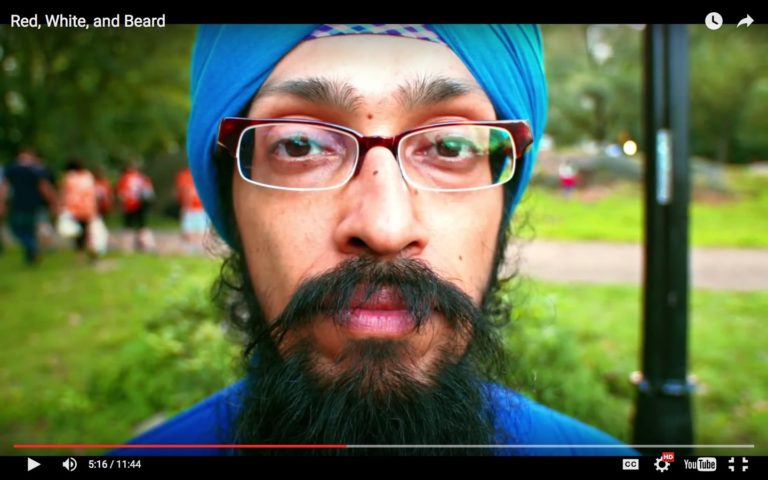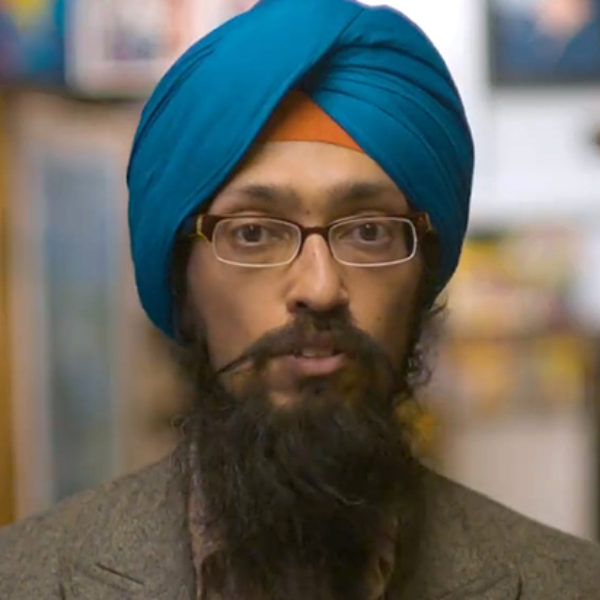
The Wild Journey of a Sikh Captain America
“How do you identify yourself?”
This question was posed to me recently during an interview for a New York Times piece on the conversation of race. Sounds like an easy question, like a check box on a form. But it’s a complicated one. Most, if not all, of us wear many demographic labels at any point in time and some, if not most, change over time.
My brief answer is: I am Vishavjit Singh, a New Yorker and a cartoonist.
Some are not satisfied with this response, given my turbaned and bearded countenance. So I quickly elaborate, having lived all over: Washington D.C., California, Ohio, Connecticut, New York — basically a nomad.
But where are you really from is the response? That is when I get to reveal my parents are South Asian, from India. That seems to settle the impulse for the question. Somehow my roots have been placed outside of our 50-state union and that maintains the imaginary space-time continuum in people’s minds.
Despite the pervasiveness and utility of demographic labels in scientific research, I have come to dislike this question. It does a disservice to our social and cultural narrative. Sometimes these labels lead to violence, not as a causal force but as a contributing factor.
We need to replace this question with, “What is your story?”
Now we get to focus on the journey rather than a few stops on it. Here is my story in a nutshell.
I was born in Washington, D.C. to a South Asian couple. My birth certificate identifies me as Caucasian. My parents moved back to their country of origin and took me along with them at the age of four. I simultaneously grew up learning Punjabi, as my mother tongue, and English, as my first language. I started wearing glasses at the age of six, which will change my life forever as a bespectacled kid to be teased my friends and foe.
My family has roots in the Sikh faith, a young 500-year-old religion started by a spiritual revolutionary named Nanak. My parents had the outer appearance of Sikhs with long hair and turbans but, in practice, they were anything but. We rarely went to temple, did believe in god’s presence, and our constant Sunday ritual was to get fresh goat meat from the butcher. I inherited the turban and long hair from my parents along with learning Sikh history from comic books and readings at school.
In 1984 after the assassination of the Indian Prime Minister at the hands of her two bodyguards who happened to be Sikh, an act of revenge for her decision to send the army into the holiest of Sikh temples five months prior. For a few days after the demise of the ruling leader, thousands of Sikhs were burnt alive under the auspices of the state apparatus. We survived a mob that surrounded our apartment, but, thanks to quick-witted kids in the block who, being part of the ethnic majority, were able to somehow reason with the bloodthirsty men.
Desiring to leave this madness behind, I came back to the land of my birth after high school, arriving first in Los Angeles. I had a few months before heading to college in Ohio. In those months many strangers seeing me on the streets greeted me with calls of “genie,” “clown,” “raghead” and the most hurtful gesture of outright laughter in my face. Two years later I had enough of being judged, defined, and ostracized for my perceived identity. In my sophomore year in college I went to a barber with my turban off, hair tied in a pony tail. With a clip of a scissors, the 20-year-old unshorn hair was gone. As I walked out with my short shaven look all eyes were of me. I had in my eyes become invisible.
With my light brown complexion, many Hispanic folks thought I was one of their own, approaching me with Spanish words. I responded with “No Espanol.” Although my first crush was a Colombian graduate student, my first relationship was with an American woman of Mexican roots.
At the same time I had fallen head over heels for books, reading them voraciously. Through them I discovered the path of Buddhism and Taoism. I moved to Berkeley to start graduate school and stayed with my brother for a few months. Taoist meditations, listening to 24 hymns from the Sikh holy book in my brother’s home, and my public health studies consumed me. Somewhere along the way, I fell in love with the hymns and almost two years later decided to try the Sikh path as a way of life.
I started growing long hair, which took almost two years to reach its pinnacle. In August 2001, while residing in Connecticut for a job in New York, I donned a turban for the first time in 10 years. A month later the attacks of 9/11 happened.
I was the ultimate outsider again in my own homeland. In me, Americans saw “Osama,” “Taliban,” “terrorist” and asked me to “Go back home.” In this tumultuous moment of darkness, a cartoon (“Find the Terrorist”) by the Pulitzer Prize-winning Mark Fiore captured my predicament to the T. He drew the Sikh man so well and portrayed the man committing hate crimes as the terrorist.
Weeks later I started creating cartoons, which I came to call Sikhtoons, full of turbaned, bearded fantasies motivated by the soap opera of real life. Almost 10 years into this endeavor, I re-created a superhero vision from 1941 first penned by Jack Kirby. I illustrated a new Captain America with a turban and beard ready to fight intolerance.
For a Brazilian-American photographer, that image morphed into a vision of me dressing as Captain America. The notion sounded ridiculous since I am skinny and bespectacled, but, following the massacre of Sikh worshippers at the hands of a white supremacist, it did not seem that crazy. So I agreed to don the uniform.
This real life manifestation of an imaginary superhero tore through a sense of what an American is supposed to look like. From that first day in June 2013 when I first stepped out to the delight of strangers, I received hugs from euphoric denizens of New York and photo requests from NYPD officers, and was pulled into weddings; it has been the start of a wild American journey.
I have donned the uniform time and again from New York to California to Kansas to Mississippi. I have received messages of love from everyone, including 9/11 responders, veterans, and those serving in armed forces today. I have showcased my art and carried the message of hope on my narrow shoulders.
In civilian clothes I always start by asking audiences where they think I am from. Just about everyone places me outside of the United States. When I ask them which ethnic group they think targets me the most in person, there is a unanimous response: white people. In reality it is black and Hispanic men who have a lion’s share of hands in targeting me. With wide eyes and jaws dropped at this revelation, I share my story.
I know what many of you are thinking. This is too complicated of a response to categorize people. Life is complicated. Our identities are complicated. White people en masse are not racists. Sikhs en masse are not foreigners. Muslims en masse are not extremists.
Our lives are drafts of stories being written, edited, and altered continuously. Only by sharing them out loud will we begin to dismantle the linguistic shallowness of labels and their potential abuse by extremists abroad and at home.

Share your reflection